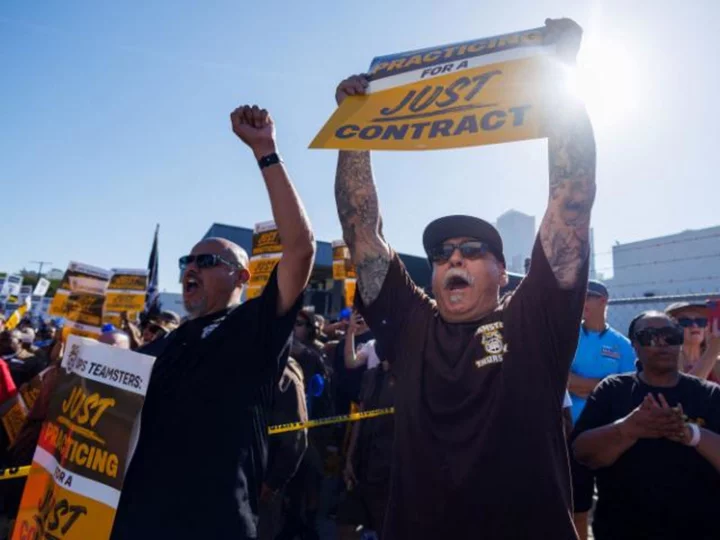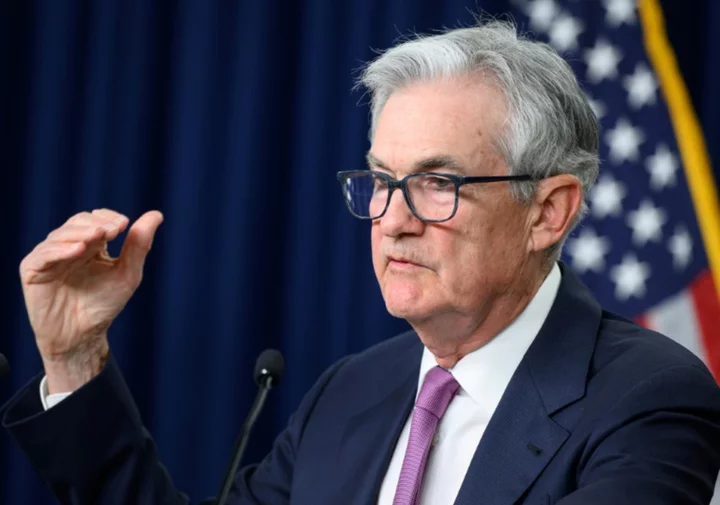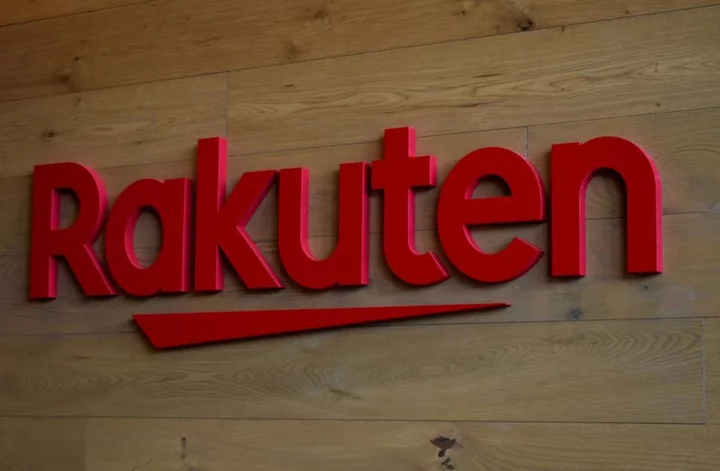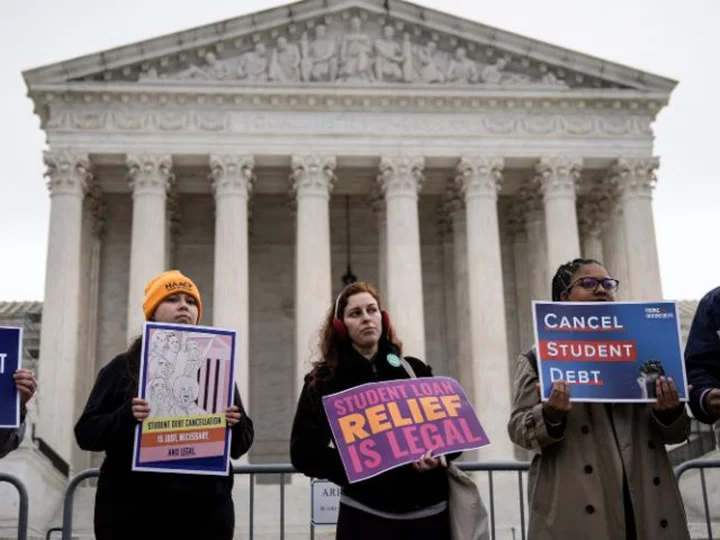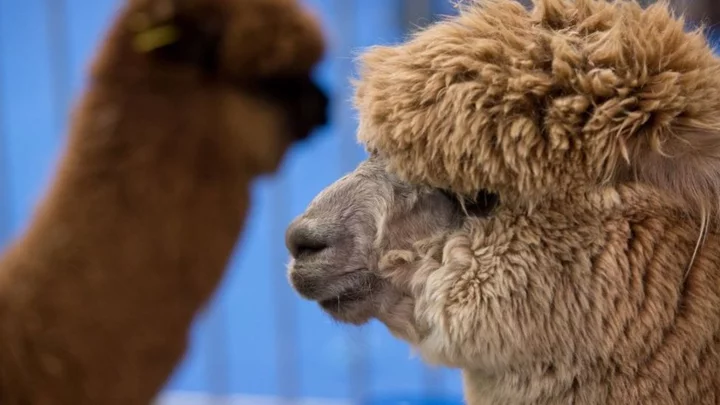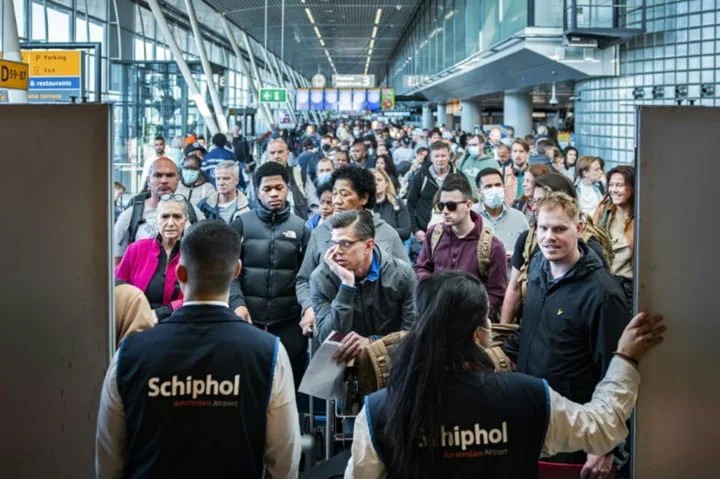There are multiple stories involving strikes and unions in the news recently.
Hollywood writers and actors have ground entertainment production to a halt as they fight for better compensation and protections from having their work co-opted by artificial intelligence.
UPS recently reached an agreement with the Teamsters, while another company, Yellow, has ceased operating, leaving many thousands of union workers out of a job.
I went to Chris Isidore, a senior writer for CNN Business, who covers organized labor, the auto industry and a whole lot more. We talked about what's going on in this moment for American unions and how it could affect everyone's life.
Our conversation, conducted over the messaging platform Slack, is below.
Regarding Teamsters at UPS and Yellow
WOLF: There are two main labor issues involving Teamsters I've been following recently: Teamsters were involved in UPS labor negotiations that nearly led to a strike and also in the ceasing of operations at the 99-year-old transportation company Yellow. What's going on with those?
ISIDORE: First of all, a couple of things about Teamsters -- don't assume the threat of a strike at UPS is over. The tentative deal still needs the majority of rank and file to ratify it to close the door on the threat of a strike. Don't know if that's certain. I could easily see rank and file voting it down.
And I wouldn't hang the end of Yellow on the Teamsters either. The union agreed not to strike despite the fact that the company had missed payments to insurance and pension funds. It had given the company billions of dollars' worth of concessions.
And the two other unionized trucking companies in that segment of the trucking industry, the LTL (less-than-truckload) industry that handles pallet-sized shipments of freight rather than full trailers of freight -- ABF Freight and Canadian-owned TForce -- are both solidly profitable.
It was debt load more than union contracts that killed Yellow. So, arguably, mismanagement.
It may be time for a UAW strike. Plus, why EVs are an issue for autoworkers
WOLF: What are the other labor standoffs people need to be aware of?
ISIDORE: Even if UPS avoids a strike, there's an excellent chance of a major strike at one or more automakers come September.
Recent decades suggest there won't be a strike at more than one at once. UAW (United Auto Workers) typically picks one "target" at which to focus negotiations and possibly strike and then demand that the other two unionized automakers agree to the same "pattern" deal.
That one really has the chance to hurt the Democrats since the union is very upset about the auto industry plans to shift to EVs (electric vehicles). They see EVs as a jobs killer because of so many fewer parts -- it takes about one-third fewer jobs to build an EV than an internal combustion engine (ICE) car. And many of the EV jobs are at battery plants being built nationwide right now, but which are joint ventures between the automakers and foreign battery companies, and thus not guaranteed to be unionized.
Even if those battery plants end up with a union, it's not clear the joint venture will agree to UAW-level wages. The one UAW-represented plant in Ohio pays roughly half of what workers are paid at an engine or transmission plant owned by one of the Big Three (US automakers) and represented by the UAW.
And then there are things like the 15,000 hotel workers in Southern California who keep going on strike for a few days at a time at different hotels.
There's also the writers/actors strike, where one of the big issues is AI and how it could cost jobs, which will be a more and more common issue across the broader economy in years to come for both unionized and nonunion workers.
Union activism is growing in red states too
WOLF: The country is essentially divided into states more welcoming to unions and those that refer to themselves as "right-to-work" states, where unions can't insist on dues from nonmembers who still benefit from their bargaining efforts. Are there any changes in that general divide? And how have efforts to unionize big brand services like Starbucks and Amazon affected things?
ISIDORE: Union activism has been growing even in the red states.
A bunch of the union organizing victories have come in right-to-work and other states. But the organizing efforts haven't produced much in the way of contracts.
Even with a far more labor-friendly NLRB (National Labor Relations Board) during the Biden administration, the law is such that there's almost no incentive for an employer like Starbucks to reach a deal with its newly unionized workers.
There have been no contracts reached yet at any of the nearly 400 Starbucks stores where the union has been certified since the first union election in December 2021.
And even with the success the union has had, it only represents a small fraction of Starbucks workers nationwide, so their ability to shut down Starbucks with a strike is extremely limited. It's more likely to hurt Starbucks with bad PR, causing liberal customers to go elsewhere or drink their coffee at home or in the office.
But the industries that are already unionized, like Teamsters at UPS and UAW at the Big Three, they can flex a lot of muscle, and they've done so.
Airlines are also agreeing to big pay raises, but their rank and file is demanding even more.
American Airlines agreed to give pilots a 42% raise. But before they could vote on that deal, United agreed to a 40% raise for its pilots that would have paid them about 2% more than American pilots, so American's pilots union told the airline it wouldn't even put its earlier deal to a vote since it was certain to be defeated. So American immediately agreed to increase the amount it had already agreed to pay.
FedEx pilots just voted down a 30% pay hike there. But it won't be able to go on strike, because despite its name, they work under the Railway Labor Act -- the same labor law that allowed Congress to impose a contract on rail workers, keeping them on the job at the end of last year rather than allowing a strike.
It's unlikely Congress would stand by and allow FedEx pilots to strike either.
Are union members tiring of Democrats?
WOLF: Democrats have long tried to be the political party speaking for union households. But my sense is that particularly in the Rust Belt, there is frustration that they do not deliver. (Recall that President Joe Biden ultimately forced rail workers not to strike). Is that a valid assumption? How are politics and unions changing?
ISIDORE: Anger over Biden and Congress imposing the contract on the rail workers can be directed at both Democrats and Republicans.
The big issue was the lack of paid sick days in the contract. The Democrats voted almost unanimously for a second part of the deal that would have required paid sick days, and it was Republicans who killed it. Then the Democrats went along with the non-sick days contract so that there wasn't a strike.
The interesting thing is most of the unions have since won paid sick days from the railroads, which were having trouble hiring the workers they needed without the sick days.
But you're right, Biden probably took more heat over the rail union contract than did the Republicans. He did do what the Teamsters wanted at UPS and stay on the sideline and not follow requests of the business community to intervene in those talks.
His labor secretary did act to help the two sides reach a deal in the longshore/port negotiations. But both sides were open to that intervention. And the longshore union wasn't threatening a strike, just engaging in activities that management said were slowing down freight through the ports. But this is another example, like UPS, where the union got much of what it wanted.
Are the unions winning or losing right now?
WOLF: At a time when there are literally not enough workers to fill all the jobs in the US, are the unions generally winning or losing in their efforts right now?
ISIDORE: The strong labor market as much as any political environment is probably what's helping the unions have the leverage they want/need right now.
But not all unions are "winning." The writers and actors are suffering. I think there's a coal mine in Alabama that was on strike for about two years and finally the union agreed to return to work without a deal, and with a number of union members who the company had targeted as engaging in violence or "misconduct" during the strike losing their jobs.
And as I said, Starbucks and Amazon haven't made any real moves to negotiate with their upstart unions.
Most unionized Americans are in the public sector
WOLF: My impression is that American union membership overall has been down, but that certain sectors -- government workers, public safety employees, teachers and service industry workers -- have been growing. How is the profile of American labor changing?
ISIDORE: You're right, the union movement is much stronger in the public sector than private sector. But it's under attack there, particularly in Florida.
Only 6% of workers in the private sector are union members today. That's down from 17% when the Labor Department started tracking that statistic 40 years ago.
But about a third of public sector employees are unionized. And nearly half of all union members are government employees, even though there are about six private sector workers for every government employee nationwide in the economy.

